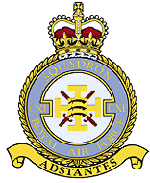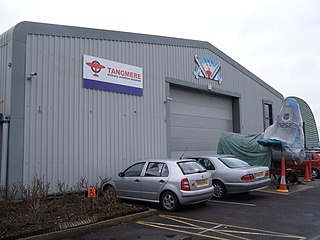Martin-Baker Aircraft Company Limited is a British manufacturer of ejection seats and safety-related equipment for aviation. The company was originally an aircraft manufacturer before becoming a pioneer in the field of ejection seats. The company's headquarters are in Higher Denham, Buckinghamshire, England, with other sites in France, Italy and the United States.

The Israel Aircraft Industries Kfir is an Israeli all-weather multirole combat aircraft based on the French Dassault Mirage 5, with Israeli avionics and an Israeli-built version of the General Electric J79 turbojet engine.

Number 111 (Fighter) Squadron, also known as No. CXI (F) Squadron and nicknamed Treble One, was a squadron of the Royal Air Force. It was formed in 1917 in the Middle East as No. 111 Squadron of the Royal Flying Corps during the reorganisation of the Egyptian Expeditionary Force after General Edmund Allenby took command during the Sinai and Palestine Campaign. The squadron remained in the Middle East after the end of the First World War until 1920 when it was renumbered as No. 14 Squadron.

A supersonic aircraft is an aircraft capable of supersonic flight, that is, flying faster than the speed of sound. Supersonic aircraft were developed in the second half of the twentieth century. Supersonic aircraft have been used for research and military purposes, but only two supersonic aircraft, the Tupolev Tu-144 and the Concorde, ever entered service for civil use as airliners. Fighter jets are the most common example of supersonic aircraft.

Newark Air Museum is an air museum located on a former Royal Air Force station at Winthorpe, near Newark-on-Trent in Nottinghamshire, England. The museum contains a variety of aircraft.

Hatzor Airbase, also titled Kanaf 4 is an Israeli Air Force (IAF) base, located in central Israel near kibbutz Hatzor Ashdod after which it is named. However, there have been no fighter jets stationed there since 2021, only patrol aircraft, UAVs and defense missiles. A Combined Operations Center for the US military and Israel has also been built there in 2021.

Wings is an hour-long televised aviation history documentary television series which aired on the Discovery Channel family of networks. It was produced by Phil Osborn.

RAAF Museum is the official museum of the Royal Australian Air Force located at RAAF Williams Point Cook, Victoria, Australia. The museum displays aircraft of significance to the RAAF from its inception as the Australian Flying Corps to the present.

The Tangmere Military Aviation Museum is a museum located on the former site of RAF Tangmere, West Sussex. The museum was opened in June 1982. Many aerospace exhibits covering the First World War to the Cold War are on display including fixed-wing aircraft, helicopters and aircraft engines.

The Sri Lanka Air Force Museum is the museum of the Sri Lanka Air Force, and its predecessor, the Royal Ceylon Air Force. Open to the public, the museum is at the SLAF Ratmalana and is maintained by the Sri Lanka Air Force.

The Militaire Luchtvaart Museum was located at Camp Zeist near the former Soesterberg Air Base. It was the official museum of the Royal Netherlands Air Force.

The Flugausstellung Peter Junior, previously the Flugausstellung Hermeskeil, is a private aviation museum in the town of Hermeskeil in the German state of Rhineland-Palatinate.

Fighter World is an Australian not-for-profit aviation heritage centre at RAAF Base Williamtown, north of Newcastle, New South Wales. It is part of RAAF Aviation and Heritage and is operated with the purpose of preserving the history of fighter operations of the RAAF. The museum's collection are predominantly fighter aircraft once operated by the RAAF. Included in the collection are historically significant aircraft including de Havilland Vampire A79-1 and Dassault Mirage IIIO A3-3, both of which were the first aircraft of their type built in Australia.

















